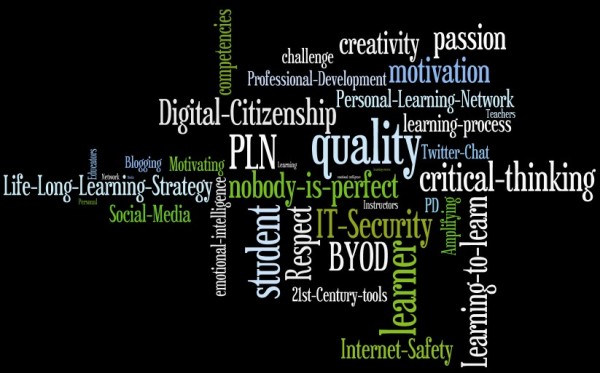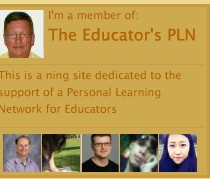
.

.
.

.
Authentic PracTICE Through Global Collaboration
 [GM] The authors of this blog post “@ICTPHMS (Dan KIRSCH‘s Blog)” and “@knolinfos (Gust MEES‘s Blog)” have met each other on Social Media “Twitter” and decided one day to work together on a common blog about “Digital CitizenShip“, a “Global Collaboration” from authors of the USA and Luxembourg (Europe) was born. Find below, please, OUR collaboration blog:
[GM] The authors of this blog post “@ICTPHMS (Dan KIRSCH‘s Blog)” and “@knolinfos (Gust MEES‘s Blog)” have met each other on Social Media “Twitter” and decided one day to work together on a common blog about “Digital CitizenShip“, a “Global Collaboration” from authors of the USA and Luxembourg (Europe) was born. Find below, please, OUR collaboration blog:
.
[GM]: below, part of the discussed on twitter
Added on 07/01/2015:

Ideas: using scenarios where the learners (students) play different roles to explain about GOOD and BAD behaviour on Social Media and let THEM blog about it. After the blogging THEY might ALSO create comics in a dialogue style whereTHEIR thoughts are included, such as I did in my blog post here ===> https://gustmeesen.wordpress.com/2012/02/13/why-ict-security-why-the-need-to-secure-a-computer/ <===.
I created these comics with dialogues with the following online program:
If you have the time, you might later create ALSO a magazine where the learners (students) bring in THEIR comics. Find some propositions of magazines below, please:
.
The above mentioned will engage YOUR learners (students), THEY will have FUN to learn and to create THEIR OWN stuff, it will boost creativity ALSO! When THEY are getting older THEY will remind WHAT THEY created as it was a pleasant learning moment in THEIR life and certainly THEY will be motivated for ===> Life-Long-Learning <===
.
WHY do WE use a bunch of different so-called tools to LEARN about Digital Citizenship?
Please check the below picture, who explains 😉
.

.
I will let “Dan KIRSCH” explain to YOU in detail about WHAT WE were working together…
.
[DK] Dan KIRSCH‘s insight
 I have utilized the collaboration with Gust via twitter on the topic of Digital Citizenship within my 8th grade ICT classes. Currently, I am teaching 3 classes with approximately 30 students in each. One of our curriculum standards is to teach Digital Citizenship/Internet Safety. I began to investigate different ways of teaching this to my 8th graders where it could be authentic and actually “practice what is being taught“. Through collaboration with Gust and other social media colleagues on twitter I began to utilize blogging (Edublogs) as a platform to teach Digital Citizenship.
I have utilized the collaboration with Gust via twitter on the topic of Digital Citizenship within my 8th grade ICT classes. Currently, I am teaching 3 classes with approximately 30 students in each. One of our curriculum standards is to teach Digital Citizenship/Internet Safety. I began to investigate different ways of teaching this to my 8th graders where it could be authentic and actually “practice what is being taught“. Through collaboration with Gust and other social media colleagues on twitter I began to utilize blogging (Edublogs) as a platform to teach Digital Citizenship.
Each student has their own blog, which is contained under my class blog. In this platform, we treat our blogs as our “social network” where students comment on blog prompts given by me or themselves containing information on Digital Citizenship, real-life scenarios, and social media. It is also used to teach other “edtech” skills; such as inserting media, using embed code, and RSS Feeds. This is the fourth year I have used edublogs and I enjoy reading what my students produce; especially the reflections and connections they make with one another.
It’s amazing to see how students communicate via the technology “more” than they would face to face; especially on how to become a positive Digital Citizen! Recently, I have begun to archive their posts on to storify (with no last names) to use for future classes you can access this via my edublog: http://mrkirsch.edublogs.org
Post: 20/03/15
The following video is one of my students who was interviewed by one of our local TV stations who came I did a story within our my classroom. The story focused on Social Media, but with an emphasis on Digital Citizenship and Internet Safety. I share this; not as I method of “bragging” but demonstrating that teaching students to be aware of what they share online “digital footprint” could and will have a lasting affect on their future. My goal is that I never have to hear about one of my former students being “trapped” because of something they said, posted, and/or shared on social media or the internet.
New Post: 04/03/15
Teaching Digital Citizenship through Authentic Practice ==> through the creation of infographics! The following (see link below) are my student(s) created infographics. They created their infographics on a specific topic of Digital Citizenship and Internet Safety and posted it on their edublog “social media platform.” Students are in 8th grade (12-13 year old).
The objective of the unit was ==> Students will create an infographic presenting student researched information on a specific Internet Safety Topic.
Post: 18/02/15
 .
.
Understanding what your digital footprint says about you. The following blog post (prompt) ==> check link here <== was given to my 8th grade students as a more interpersonal digital citizenship reflection. The previous posts have been more focused on the “broad” perspective of Digital Citizenship and what it is ==> what it means. <== The objective was for students to take an interpersonal “look” at themselves and reflect on the ==>HOW TO<== become & maintain a positive digital footprint as they progress through their high school years, and into college. My goal as their ICT instructor is to make students realize that once they enter college and are “away” from parents/guardians peer pressure can and often times does involve them in negative way. The point is ==> teaching students to be aware of this now they will be able to think twice before they “make the choice” to share/post negative material on the internet/social media, which in return could damage their “digital footprints.”
Post: 06/02/15

Student example as seen on mrkirsch.edublogs.org of Digital Citizenship.
Teaching Digital Citizenship Through Comics
Objective:
The objective of the post is for students to learn about Digital Citizenship through stories.
Main Idea:
The following link is to my 8th grade students edublogs. The focus of this blog post come from Gust MEES. My students created comic strips utilizing the online website Pixton. The objective of the post is for students to learn about Digital Citizenship through stories. They are required to have a Digital Citizenship “dilemma” and at the end of their story they must have a positive outcome and/or resolution to the situation. There scenarios can be anything related to Digital Citizenship/Internet Safety. Please check the link below to see a gallery of my students finished Digital Citizenship comics.
The following link is a curate blog reflections from my students on Digital Citizenship/Internet Safety. This was a “lead-up” activity to the comic strips seen above. The curation tool I utilized for this is Storify.
Teaching with Content Curation (added February, 3, 2015)
Content curation is the “…process of collecting, organizing and displaying information relevant to a particular topic. Teacher content curation can be used by students and students can be asked to show expertise with examples of curation.” In my 8th grade ICT class we will be completing webquests on content curation as a teach method of introducing students to “Content Curation.” The following text reviews what content curation is and it’s purpose, along with several content curation platforms, what a webquest is, and followed by a lesson plan I will use in my classes.
- create stories or timelines using social media such as Twitter, Facebook and Instagram.
Flipboard:
 .
.- .
- Flipboard is your personal magazine.
- It’s a single place to discover, collect and share the news you care about.
- Add your favorite social networks, publications and blogs to stay connected with topics and people closest to you.
- .
.
Scoop.it!:
- Build engaged audiences through publishing by curation.
- Think of it as a way to build content.
- You can bookmark and share your sources.
- Can be used to increase your authority on a topic.

Paper.li
- Automatically find, publish & promote engaging articles, photos and videos from across the web
- Display Content Marketing Information.

Introduction into Content Curation
What is Content Curation?
Content curation is the “…process of sorting through the vast amounts of content on the web and presenting it in a meaningful and organized way around a specific theme. The work involves sifting, sorting, arranging, and publishing information.” A content curator picks the best content that is “…important and relevant to share with their community (in the case our class community). It isn’t unlike what a museum curator does to produce an exhibition: They identify the theme, they provide the context, they decide which paintings to hang on the wall, how they should be annotated, and how they should be displayed for the public.”
Content curation is not about collecting links or being an information pack rat, it is more about “…putting them into a context with organization, annotation, and presentation. Content curators provide a customized selection of the best and most relevant resources on a very specific topic or theme” (in this case ours will be on Digital Citizenship, ICT, and Educational Technology). A content curator “…continually seeks, makes sense of, and shares the best and most relevant content on a particular topic online.”
Why is Content Curation Valuable?
Individuals and organizations are making, sharing media, and content all over the social web. For example, on Facebook the average user creates 90 pieces of content each month. If you “…multiply that by the 800 million Facebook users, it isn’t surprising that data or content on the Internet is measured in billions of gigabytes.” Essentially, we are living an era of content overload!!! A content curator offers high value to anyone looking for quality content because finding that information (and making sense of it) requires more and more time, attention, and focus.
For individuals and organizations, content curation can help establish their “thought” leadership and capture attention in today’s information “overloaded” world. Content curation can “…help your organization become the go-to authority on an issue or topic area.” It can be done as simply as writing a blog post (this is excatly what we will be doing with our edublogs in my classes) with links or sharing annotated links on Twitter around your topic.

.
Getting Started
This questionnaire (citation on pic) can help you think through a plan for content curation before you dive into the curation tools. There has been an explosion of tools and you can distracted by useless features. Even better, “… perhaps focus on the skills with the tools you know how to use already.” You might want to integrate the process of content curation into a channel you’re already using (in my class students will be including this within a category on their blogs).
Citation:
Kanter, B. (n.d.). Beth’s Blog. Retrieved January 14, 2015, from http://www.bethkanter.org/
[DK] Please check the link ==> Content Curation Lesson Plan to access my recently created content curation lesson plan for my 8th grade students. This lesson plan is posted for colleagues in my PKM to access.
[DK] Great twitter chat archive on Digital Citizenship via @mrkempnz & @BevLadd (7/5/2015) curated on storify.
[GM] Through curation one can build up ALSO its own “Personal [Professional] Knowledge Management” (PKM), please check below:
Through curation and using Twitter one builds up ALSO a “PLN” (Personal Learning Network), please check below:
.
Creating a Webquest
 Webquests are useful teaching tools for educators. An imaginative webquest can capture the attention of a student as he or she learns about any number of topics. For instance, I have chosen to use my classes edublogs as our webquest platform where we can incorporate curated content on Digital Citizenship.
Webquests are useful teaching tools for educators. An imaginative webquest can capture the attention of a student as he or she learns about any number of topics. For instance, I have chosen to use my classes edublogs as our webquest platform where we can incorporate curated content on Digital Citizenship.
A teacher who wants to bring his or her own webquest ideas to life must make a detailed plan. Some teachers begin by choosing a web quest template. There are online resources available that outline the specific elements of a webquest. For example, a webquest has an introduction that explains its purpose to students. A webquest also includes a task that lets students know what they are expected to do. Next, the process sets out a path for students to follow that leads them to relevant information. Those are just a few of the steps that a teacher needs to fulfill in order to make an effective webquest.
==> Mr. Kirsch’s Sample Content Curation Webquest <==
Teaching with Content Curation Lesson Plan
- Focus Question: Do students know where to get quality information from the Internet?
- Additional Questions: 1. What resources do teachers need to find quality information on the Internet (i.e., content curation)?
- 2. How should the Internet be used in the classroom?
Lesson Goals/Objectives: To get students to think how to best use the Internet in their classroom.
Activity Description:
- Spend time discussing the basics of Internet searches (e.g., have students with more experience help others). See Evaluating Websites from the University of California Berkley in Resources. Talk about Search engines and other ways to find information (2nd and 3rd tier investigation).
- Create a webquest (using our edublogs) and have students write about what sites they come up with using our “curated content.”
- Have the students support why their “curated content” was appropriate for this lesson within their blog posts.
- Students will then be assigned a topic (social media, educational technology, digital citizenship, and/or online security) to begin their curated content. Once content as been established and shared via WordPress or social media the students will then blog (webquest) about their thoughts on curated content.
In The 21st Century, The Word TEACHing Gets Replaced By LEARNING TO LEARN, How To
.

Click the above image, please, to access the article.
How To Design A Course About Digital CitizenShip?
Please check below, on How-To YOU could create YOUR own course, based on PracTICE AND student centered:
.

.
.
THE Whole FREE Course On ONLY One Interactive Image
Click the image below, please and you will get directed to the “interactive image“. You need to move then your cursor above the image and you will see black “spots“. Click them, you will get directed to FREE courses on each “station” 😉
.

.
.
Using A Flowchart To Design The Course
Check below, please, to find out the how-to.
.

Click the above image, please, to display it larger.
.
THE Whole FREE Course Using FlowCharts On ONLY One Interactive Image
Click the image below, please and you will get directed to the “interactive image“. You need to move then your cursor above the image and you will see black “spots“. Click them, you will get directed to FREE courses on each “station” 😉
.

.
.
Related links
.

↑ Grab this Headline Animator
.
 Please find below related links to the discussed above, such as:
Please find below related links to the discussed above, such as:
How to Use Storify:
Luckily, it’s easy.
 .
.
- First, create an account at Storify (you can log in with Twitter or Facebook).
- Click the blue “Create a Story” button in the top right hand corner.
- Look at the right side of the new screen where the icons of your favorite social media websites reside.
- Click on any social media icon (like Twitter), then put in a username for that network you want to search. You’ll see all the recent Tweets from that person/hashtag/search query.
- Now, start dragging content from the right hand panel from the social media networks you are searching into the left hand panel where you are telling your story. Add words or titles. You are finished!! A story told in text and pictures via social media updates.
Want an Example?
Here’s one of my classes using storify. It’s a recap of our Digital Citizenship Chats we did on our class blog.
.
Keywords necessary to create this blog post: @ICTPHMS, @Knolinfos, collaboration, Global Collaboration, Education, Global Education, TRUST, #digcit, Digital CitizenShip, digital citizen, Cyber-Security, Internet-Safety, Best Practices, Learning To Learn, Learning By Doing, Student centered, Coaching, #EdTech #tools, #esafety, #blogging, ICT, #edblogs, authentic practice.
.
|
 L’auteur Gust MEES est Formateur andragogique / pédagogique TIC, membre du “Comité Conseil” de “Luxembourg Safer Internet” (LuSI), appelé maintenant BEESECURE, partenaire officiel (consultant) du Ministère de l’éducation au Luxembourg du projet ”MySecureIT“, partenaire officiel du Ministère du Commerce au Luxembourg du projet ”CASES” (Cyberworld Awareness and Security Enhancement Structure). L’auteur Gust MEES est Formateur andragogique / pédagogique TIC, membre du “Comité Conseil” de “Luxembourg Safer Internet” (LuSI), appelé maintenant BEESECURE, partenaire officiel (consultant) du Ministère de l’éducation au Luxembourg du projet ”MySecureIT“, partenaire officiel du Ministère du Commerce au Luxembourg du projet ”CASES” (Cyberworld Awareness and Security Enhancement Structure).
The author Gust MEES is ICT Course Instructor, ”Member of the Advisory Board” from “Luxembourg Safer Internet” (LuSI), BEESECURE, Official Partner (Consultant) from the Ministry of Education in Luxembourg, project “MySecureIT“, Official Partner from the Ministry of Commerce in Luxembourg, project “CASES” (Cyberworld Awareness and Security Enhancement Structure).
|
..
|

.
The author Dan KIRSCH teaches courses in Information/Communications & Technology (ICT) and Career/Technical Education (CTE) for students in grades 6-8 at Patrick Henry Middle School in South Dakota, USA. Students in his classes focus on Social Media, Educational Technology, and most importantly Digital Citizenship. Currently, I have the priviledge to be on my school districts ICT curriculum committee. We are rewriting and updating our ICT curriclulum in grades 6-8 for the 2015-2016 school year.
.
You can find me also on:
|
.
.
Stay tuned for next blog posts 😉
.

 L’auteur Gust MEES est Formateur andragogique / pédagogique TIC, membre du “Comité Conseil” de “Luxembourg Safer Internet” (LuSI), appelé maintenant BEESECURE, partenaire officiel (consultant) du Ministère de l’éducation au Luxembourg du projet ”MySecureIT“, partenaire officiel du Ministère du Commerce au Luxembourg du projet ”CASES” (Cyberworld Awareness and Security Enhancement Structure).
L’auteur Gust MEES est Formateur andragogique / pédagogique TIC, membre du “Comité Conseil” de “Luxembourg Safer Internet” (LuSI), appelé maintenant BEESECURE, partenaire officiel (consultant) du Ministère de l’éducation au Luxembourg du projet ”MySecureIT“, partenaire officiel du Ministère du Commerce au Luxembourg du projet ”CASES” (Cyberworld Awareness and Security Enhancement Structure).











































































